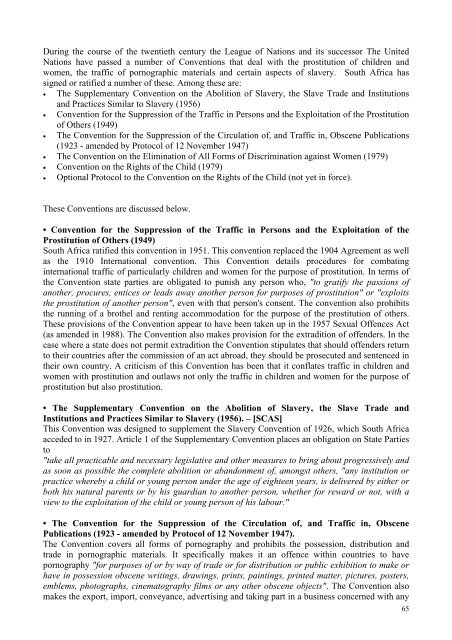The trafficking of children for purposes of sexual exploitation
The trafficking of children for purposes of sexual exploitation
The trafficking of children for purposes of sexual exploitation
You also want an ePaper? Increase the reach of your titles
YUMPU automatically turns print PDFs into web optimized ePapers that Google loves.
During the course <strong>of</strong> the twentieth century the League <strong>of</strong> Nations and its successor <strong>The</strong> United<br />
Nations have passed a number <strong>of</strong> Conventions that deal with the prostitution <strong>of</strong> <strong>children</strong> and<br />
women, the traffic <strong>of</strong> pornographic materials and certain aspects <strong>of</strong> slavery. South Africa has<br />
signed or ratified a number <strong>of</strong> these. Among these are:<br />
• <strong>The</strong> Supplementary Convention on the Abolition <strong>of</strong> Slavery, the Slave Trade and Institutions<br />
and Practices Similar to Slavery (1956)<br />
• Convention <strong>for</strong> the Suppression <strong>of</strong> the Traffic in Persons and the Exploitation <strong>of</strong> the Prostitution<br />
<strong>of</strong> Others (1949)<br />
• <strong>The</strong> Convention <strong>for</strong> the Suppression <strong>of</strong> the Circulation <strong>of</strong>, and Traffic in, Obscene Publications<br />
(1923 - amended by Protocol <strong>of</strong> 12 November 1947)<br />
• <strong>The</strong> Convention on the Elimination <strong>of</strong> All Forms <strong>of</strong> Discrimination against Women (1979)<br />
• Convention on the Rights <strong>of</strong> the Child (1979)<br />
• Optional Protocol to the Convention on the Rights <strong>of</strong> the Child (not yet in <strong>for</strong>ce).<br />
<strong>The</strong>se Conventions are discussed below.<br />
• Convention <strong>for</strong> the Suppression <strong>of</strong> the Traffic in Persons and the Exploitation <strong>of</strong> the<br />
Prostitution <strong>of</strong> Others (1949)<br />
South Africa ratified this convention in 1951. This convention replaced the 1904 Agreement as well<br />
as the 1910 International convention. This Convention details procedures <strong>for</strong> combating<br />
international traffic <strong>of</strong> particularly <strong>children</strong> and women <strong>for</strong> the purpose <strong>of</strong> prostitution. In terms <strong>of</strong><br />
the Convention state parties are obligated to punish any person who, "to gratify the passions <strong>of</strong><br />
another, procures, entices or leads away another person <strong>for</strong> <strong>purposes</strong> <strong>of</strong> prostitution" or "exploits<br />
the prostitution <strong>of</strong> another person", even with that person's consent. <strong>The</strong> convention also prohibits<br />
the running <strong>of</strong> a brothel and renting accommodation <strong>for</strong> the purpose <strong>of</strong> the prostitution <strong>of</strong> others.<br />
<strong>The</strong>se provisions <strong>of</strong> the Convention appear to have been taken up in the 1957 Sexual Offences Act<br />
(as amended in 1988). <strong>The</strong> Convention also makes provision <strong>for</strong> the extradition <strong>of</strong> <strong>of</strong>fenders. In the<br />
case where a state does not permit extradition the Convention stipulates that should <strong>of</strong>fenders return<br />
to their countries after the commission <strong>of</strong> an act abroad, they should be prosecuted and sentenced in<br />
their own country. A criticism <strong>of</strong> this Convention has been that it conflates traffic in <strong>children</strong> and<br />
women with prostitution and outlaws not only the traffic in <strong>children</strong> and women <strong>for</strong> the purpose <strong>of</strong><br />
prostitution but also prostitution.<br />
• <strong>The</strong> Supplementary Convention on the Abolition <strong>of</strong> Slavery, the Slave Trade and<br />
Institutions and Practices Similar to Slavery (1956). – [SCAS]<br />
This Convention was designed to supplement the Slavery Convention <strong>of</strong> 1926, which South Africa<br />
acceded to in 1927. Article 1 <strong>of</strong> the Supplementary Convention places an obligation on State Parties<br />
to<br />
"take all practicable and necessary legislative and other measures to bring about progressively and<br />
as soon as possible the complete abolition or abandonment <strong>of</strong>, amongst others, "any institution or<br />
practice whereby a child or young person under the age <strong>of</strong> eighteen years, is delivered by either or<br />
both his natural parents or by his guardian to another person, whether <strong>for</strong> reward or not, with a<br />
view to the <strong>exploitation</strong> <strong>of</strong> the child or young person <strong>of</strong> his labour."<br />
• <strong>The</strong> Convention <strong>for</strong> the Suppression <strong>of</strong> the Circulation <strong>of</strong>, and Traffic in, Obscene<br />
Publications (1923 - amended by Protocol <strong>of</strong> 12 November 1947).<br />
<strong>The</strong> Convention covers all <strong>for</strong>ms <strong>of</strong> pornography and prohibits the possession, distribution and<br />
trade in pornographic materials. It specifically makes it an <strong>of</strong>fence within countries to have<br />
pornography "<strong>for</strong> <strong>purposes</strong> <strong>of</strong> or by way <strong>of</strong> trade or <strong>for</strong> distribution or public exhibition to make or<br />
have in possession obscene writings, drawings, prints, paintings, printed matter, pictures, posters,<br />
emblems, photographs, cinematography films or any other obscene objects". <strong>The</strong> Convention also<br />
makes the export, import, conveyance, advertising and taking part in a business concerned with any<br />
65
















